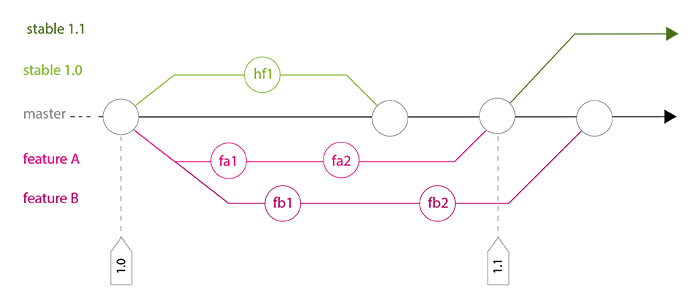[Git] An efficient GIT workflow for mid/long term projects
reference : http://fle.github.io/an-efficient-git-workflow-for-midlong-term-projects.html
Our full-web project has been going on for nearly two years and is running in production for over 18 months. I think it's my first project without any headache about our codebase and VCS management. So, I'll present our GIT workflow which has proven to be very effective for now.
Context
- Several developers
- Several staging/pre-production servers, several (non-synchronous) production servers
- Monthly releases (more or less) with delivery on staging, then on production servers
- On servers, basecode is directly pulled from the GIT repository with fabric
Rules
To handle this, we have set some simple rules:
- One (and only one) maintainer, who manage GIT repository and releases
- Never commit directly on master
- Never rebase master on any branch
- Do not get out of planned workflow
Workflow
Master branch
Our branch master is the common trunk and simply contains all the codebase of the next release. Since we don't work directly on it, it evolves mainly with merges.

Development branches
When a developer starts a new feature or a bugfix, he creates a new branch from master HEAD
$ (master) git checkout -b featureA
$ (featureA) git commit -a -m "featureA part 1"
$ (featureA) git commit -a -m "featureA part 2"

He follows branch master evolution and regularly ensures his code still works, by rebasing his branch featureA on branch master.
$ (featureA) git rebase master
When his developments are done (commits fa1 / fa2 in schema below), he does a last rebase. Thanks to this:
- he ensures that the maintainer will be able to merge easily (maintainer should not need to read code deeply and search why there are conflicts)
- if tests pass on development branch after rebase, they should pass on master after merge, so we ensure that branch ``master`` is always working well
Possibly, it will be the good time to clean the development branch to let it neat just when it is finished.

The maintainer can now merge this branch in master peacefully, without big conflict troubles. As the maintainer, I like to use no-ff option to force a merge commit, so history can stay really readable (we easily see where the branch has started and where it has been merged).
$ (master) git merge --no-ff featureA

Now that the branch has been merged, the developer should remove his development branch.
$ (master) git branch -d featureA
$ (master) git push origin :featureA
Stable branches
When we prepare a release, we update CHANGELOG (with our workflow, a git log --oneline should be quite clear to do that) and tag the branch master (optional), then we start a stable branch.
$ (master) git tag 1.0
$ (master) git checkout -b stable1.0
$ (stable1.0) git push origin stable1.0
This branch is deployed on different servers.
While development goes on, we possibly have to do some hotfixes (for example: commit hf1 in schema below), that must be sent in production quickly. These hotfixes are done directly on concerned stable branch.

Regularly, the maintainer merges stable branch in master to bring back these commits. This action is particularly important before the next release.
$ (master) git merge --no-ff stable1.0
We found this method really useful because:
- each stable branch has its own life and doesn't take care of branch master evolution, so we can hotfix stable branche freely and without stress
- we ensure that no hotfix commit has been lost before next release (avoid regressions)
A complete history example

Conclusion
Of course, there are several GIT workflows which can be very efficient, but we found many advantages in working with this method, and no real issue:
- Branch master is always clean and working well
- Developers don't care about GIT whole workflow
- We can fix stable branch without asking ourselves what happened on master since last release
- We ensure that each stable release contains new features and possible fixes
- Always working with branches and using``-no-ff``option make history really clear !
- This workflow is scalable (number of developers or branches doesn't really matter)
[Git] An efficient GIT workflow for mid/long term projects的更多相关文章
- git项目实战常用workflow和命令
一个从无到有的项目大体经历-创建项目目录,创建repo,配置过滤集,配置git user,导入已有基础代码入库,将库放到central去,建立分支,修改代码,checkin代码,分支上 测试验证代码, ...
- Git基本命令 -- 创建Git项目
在这里下载git:https://git-scm.com/ 安装的时候, 如果是windows系统的话, 可以勾选unix的命令行工具, 这样在windows命令行下会多出很多命令, 例如ls. Gi ...
- git push and git pull
原文链接 git push 通常对于一个本地的新建分支,例如git checkout -b develop, 在develop分支commit了代码之后,如果直接执行git push命令,develo ...
- git init和git init -bare区别
1 Git init 和 git init –bare 的区别 用"git init"初始化的版本库用户也可以在该目录下执行所有git方面的操作.但别的用户在将更新push上来的 ...
- 小丁带你走进git世界一-git简单配置
小丁带你走进git世界一-git简单配置 1.github的简单配置 配置提交代码的信息,例如是谁提交的代码之类的. git config –global user.name BattleHeaer ...
- Git(远程仓库:git@oschina)-V2.0
1.注册git@osc(也就是“码云”) 这里会提示注册密码==push密码,反正一定要记住的东西. 2.安装git 这里要设置个人信息 git config --list //查看git信息 g ...
- git pull和git fetch的区别
Git中从远程的分支获取最新的版本到本地有这样2个命令:1. git fetch:相当于是从远程获取最新版本到本地,不会自动merge Git fetch origin master git log ...
- [.net 面向对象程序设计进阶] (26) 团队开发利器(五)分布式版本控制系统Git——图形化Git客户端工具TortoiseGit
[.net 面向对象程序设计进阶] (26) 团队开发利器(五)分布式版本控制系统Git——图形化Git客户端工具TortoiseGit 读前必备: 接上篇: 分布式版本控制系统Git——使用GitS ...
- Git:Git初体验——Git安装配置
作为即将成为一个程序员的男人,一直在听别人说Git多好多好,之前也随便了解了一些,但是始终没有决心去学会.现在大四了,只有毕设和一门开学六七周只去过一次课的全员必修课外,也没有什么事情做,何不去做这些 ...
随机推荐
- 使用VSCode配置简单的vue项目
由于最近要使用的项目框架为前后端分离的,采用的是vue.js+webAPI的形式进行开发的.因为之前我没有接触过vue.js,也只是通过视频文档做了一些简单的练习.今天技术主管说让大家熟悉下VSCod ...
- 易普优高级计划排程Light版助力中小企业实现精益化计划
易普优高级计划排程Light版助力中小企业实现精益化计划 一.业务与排产需求 根据统计,目前中小企业已经占到我国工业企业总数的95%以上,对中国GDP贡献超过60%,税收超过了50%,提供了70%的进 ...
- redhat重置密码
当忘记虚拟机密码时怎么办? 1.启动虚拟机,当虚拟机显示输入enter启动时输入e 2.再次用上下键选中你平时启动linux的那一项(类似于kernel /boot/vmlinuz-2.4.18-14 ...
- xmanager
[root@upright91 run]# ./runBenchmark.sh updbtpcc.properties sqlTableCreates Exception in thread &quo ...
- php匹配邮箱正则
php匹配邮箱正则 '/[a-z0-9&\-_.]+@[\w\-_]+([\w\-.]+)?\.[\w\-]+/is'
- poj2387- Til the Cows Come Home(最短路)
此为转载:http://blog.csdn.net/wangjian8006: 题目大意:有N个点,给出从a点到b点的距离,当然a和b是互相可以抵达的,问从1到n的最短距离 解题思路: 模版题,这题要 ...
- 《Android源码设计模式》--享元模式
No1: 享元模式是对象池的一种实现.享元模式用来尽可能减少内存使用量,它适合用于可能存在大量重复对象的场景,来缓存可共享的对象,达到对象共享.避免创建过多对象的效果,这样一来就可以提升性能.避免内存 ...
- 【UOJ #221】【NOI 2016】循环之美
http://uoj.ac/problem/221 因为\(a\)和\(b\)不互质时,\(\frac ab=\frac{\frac a{(a,b)}}{\frac b{(a,b)}}\),所以只用求 ...
- [BZOJ 4870] 组合数问题
Link: 传送门 Solution: 组合数的式子都可以先想想能不能递推,写出来就是: $\sum C_{n*k}^{i*k+r}=\sum C_{n*k-1}^{i*k+r}+\sum C_{n* ...
- BZOJ.4552.[HEOI2016/TJOI2016]排序(线段树合并/二分 线段树)
题目链接 对于序列上每一段连续区间的数我们都可以动态开点建一棵值域线段树.初始时就是\(n\)棵. 对于每次操作,我们可以将\([l,r]\)的数分别从之前它所属的若干段区间中分离出来,合并. 对于升 ...
